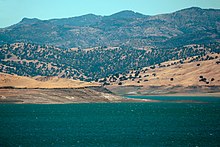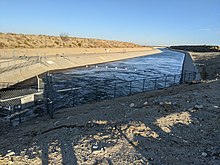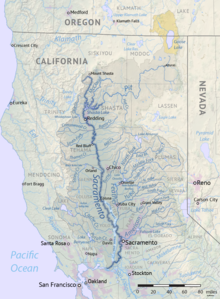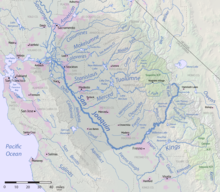California Aqueduct
California Aqueduct | |
|---|---|
 TheDelta–Mendota Canal(left) and the California Aqueduct (right) nearTracy, California | |
| Coordinates | 37°49′47″N121°33′25″W/ 37.8297°N 121.557°W |
| Begins | Clifton Court Forebay,Contra Costa County 37°49′47″N121°33′25″W/ 37.82972°N 121.55694°W |
| Ends | West Branch Castaic Lake,Los Angeles County 34°35′15″N118°39′25″W/ 34.587379°N 118.656893°W East Branch Silverwood Lake,San Bernardino County 34°18′12″N117°19′12″W/ 34.303457°N 117.319908°W Coastal Branch Lake Cachuma,Santa Barbara County 34°35′12″N119°58′52″W/ 34.586656°N 119.980975°W |
| Official name | Governor Edmund G. Brown California Aqueduct |
| Maintained by | California Department of Water Resources |
| Characteristics | |
| Total length | Total: 444 mi (715 km) Main: 304 mi (489 km) East Branch: 140 mi (230 km) |
| Width | 110 ft (34 m) max. |
| Height | 40 ft (12 m) max. |
| Capacity | 13,100 cu ft/s (370 m3/s) max |
| History | |
| Construction start | 1963 |
| Opened |
|
| Location | |
 | |
| References | |
| [3] | |
TheGovernor Edmund G. Brown California Aqueductis a system of canals, tunnels, and pipelines that conveys water collected from theSierra Nevada Mountainsand valleys ofNorthernandCentral CaliforniatoSouthern California.[4]Named after California GovernorEdmund Gerald "Pat" Brown Sr.,the over 400-mile (640 km) aqueduct is the principal feature of theCalifornia State Water Project.
The aqueduct begins at theClifton Court Forebayat the southwestern corner of theSacramento–San Joaquin River Delta.The aqueduct then heads south, eventually splitting into three branches: the Coastal Branch, ending atLake CachumainSanta Barbara County;the West Branch, conveying water toCastaic LakeinLos Angeles County;and the East Branch, connectingSilverwood LakeinSan Bernardino County.
TheDepartment of Water Resources (DWR)operates and maintains the California Aqueduct, including onepumped-storage hydroelectricplant,Gianelli Power Plant.Gianelli is located at the base ofSan Luis Dam,which formsSan Luis Reservoir,the largest offstreamreservoirin the United States.[5]
The Castaic Power Plant, while similar and which is owned and operated by theLos Angeles Department of Water and Power,is located on the northern end ofCastaic Lake,whileCastaic Damis located at the southern end.
Land subsidencehas occurred along the aqueduct and has had a steady increase since its relatively stable state post construction of the aqueduct.
The aqueduct system
[edit]
The aqueduct serves 35 million people and 5.7 million acres of farmland,[6]and begins at theSan Joaquin-Sacramento River Deltaat theBanks Pumping Plant,which pumps from theClifton Court Forebay.Water is pumped by the Banks Pumping Plant to theBethany Reservoir.The reservoir serves as a forebay for theSouth Bay Aqueductvia theSouth Bay Pumping Plant.From the Bethany Reservoir, the aqueduct flows by gravity approximately 60 mi (97 km) to theO'Neill Forebayat theSan Luis Reservoir.From the O'Neill Forebay, it flows approximately 16 mi (26 km) to theDos Amigos Pumping Plant.After Dos Amigos, the aqueduct flows about 95 mi (153 km) to where theCoastal Branchsplits from the "main line". The split is approximately 16 mi (26 km) south-southeast ofKettleman City.After the coastal branch, the line continues by gravity another 66 mi (106 km) to the Buena Vista Pumping Plant. From the Buena Vista, it flows approximately 27 mi (43 km) to the Teerink Pumping Plant. After Teerink it flows about 2.5 mi (4.0 km) to the Chrisman Pumping Plant. Chrisman is the last pumping plant beforeEdmonston Pumping Plant,which is 13 mi (21 km) from Chrisman. South of the plant the west branch splits off in a southwesterly direction to serve theLos Angeles Basin.At Edmonston Pumping Plant it is pumped 1,926 ft (587 m) over theTehachapi Mountains.[7]
Water flows through the aqueduct in a series of abrupt rises and gradual falls. The water flows down a long segment, built at a slight grade, and arrives at a pumping station powered byPath 66orPath 15.The pumping station raises the water, where it again gradually flows downhill to the next station. However, where there are substantial drops, the water'spotential energyis recaptured byhydroelectricplants. The initial pumping station fed by the Sacramento River Delta raises the water 240 ft (73 m), while a series of pumps culminating at the Edmonston Pumping Plant raises the water 1,926 ft (587 m) over the Tehachapi Mountains.
A typical section has aconcrete-lined channel 40 feet (12 m) at the base and an average water depth of about 30 ft (9.1 m). The widest section of the aqueduct is 110 feet (34 m) and the deepest is 32 feet (9.8 m). Channel capacity is 13,100 cubic feet per second (370 m3/s) and the largest pumping plant capacity at Dos Amigos is 15,450 cubic feet per second (437 m3/s).
A 2021 study published inNature Sustainabilityestimated that the installation ofsolar panelsover the canal could potentially reduce annual waterevaporationby 11–22 million US gallons per mile (27,000,000–51,000,000 L/km) of canal. While electricity generated by the solar panels could be used by the aqueduct's pumping systems, the study also considered the possibility of supplying power to irrigation systems in theCentral Valleyto reduce reliance on diesel-powered irrigation pumps. Similar canal-spanning solar installations have been demonstrated in India, including a steel truss design inGujaratand a suspension cable design inPunjab.[8]
Branches
[edit]From its beginning until its first branch, the aqueduct passes through parts of Contra Costa, Alameda, San Joaquin, Stanislaus, Merced, Fresno, and Kings counties. The aqueduct then divides into three branches: theCoastal Branchin the Central Valley, and theEastandWest Branchesafter passing over theTehachapi Mountains.

Coastal Branch
[edit]The Coastal Branch splits from the main line 11.3 mi (18.2 km) south-southeast ofKettleman CitytransitingKings County,Kern County,San Luis Obispo County,andSanta Barbara Countyto deliver water to the coastal cities ofSan Luis Obispo,Santa Maria,andSanta Barbara.[9]The Coastal Branch is 116 mi (187 km) and has five pump stations. Phase I, an above-ground aqueduct totaling 15 mi (24 km) from where it branches from the California Aqueduct, was completed in 1968. With construction beginning in 1994, Phase II consists of 101 mi (163 km) of a 42–57-inch (1.07–1.45 m) diameter buried pipeline extending from the Devils Den Pump Plant, and terminates at Tank 5 onVandenberg Space Force BaseinSanta Barbara County.The Central Coast Water Authority (CCWA) extension, completed in 1997, is a (30–39 in) (76–99 cm) diameter pipeline that travels 42 mi (68 km) from Vandenberg throughVandenberg Village,Lompoc,Buellton,andSolvangwhere it terminates atLake CachumainLos Padres National Forest.[10]
Coastal Branch facilities include:[11]
- Las Perillas Pumping Plant
- Badger Hill Pumping Plant
- Devil's Den Pumping Plant
- Bluestone Pumping Plant
- Polonio Pass Pumping Plant
- Polonio Pass Water Treatment Plant
- Cuesta Tunnel[12]
- Santa Ynez Pumping Facility[12]
East Branch
[edit]
The aqueduct splits off into the East Branch and West Branch in extreme southern Kern County, north of the Los Angeles County line. The East Branch suppliesLake Palmdaleand terminates atLake Perris,in the area of theSan Gorgonio Pass.It passes through parts of Kern, Los Angeles, San Bernardino, and Riverside counties.
East Branch facilities include:[11]
- Tehachapi East Afterbay
- Alamo Power Plant
- Pearblossom Pumping Plant
- Mojave Siphon
- Mojave Siphon Power Plant
- Cedar Springs Dam
- Silverwood Lake
- San Bernardino Intake Structure
- San Bernardino Tunnel
- Devil Canyon Power Plant
- Devil Canyon Afterbay 1 and Afterbay 2
- Greenspot Pump Station (Backup)
- Citrus Reservoir
- Citrus Pump Station
- Crafton Hills Reservoir
- Crafton Hills Pump Station
- Cherry Valley Pump Station
- Perris Lake and Dam
West Branch
[edit]The West Branch continues to head towards its terminus atPyramid LakeandCastaic Lakein theAngeles National Forestto supply the western Los Angeles basin. It passes through parts of Kern and Los Angeles counties.
West Branch facilities include[11]
- Oso Pumping Plant
- Peace Valley Pipeline
- Warne Powerplant
- Angeles Tunnel
- Castaic Power Plant
Bikeway
[edit]When it was open, theCalifornia Aqueduct Bikewaywas the longest of the paved paths in theLos Angeles area,at 107 miles (172 km) long fromQuail Lakenear Gorman in theSierra Pelona Mountainsthrough the desert toSilverwood Lakein theSan Bernardino Mountains.This path was closed in 1988 due to bicyclist safety and liability issues. It is expected to remain closed indefinitely due to the continued liability issues and an increased focus on security, especially after theSeptember 11, 2001 attacks.
Pumping stations
[edit]- Phase I, canal
- Las Perillas Pumping Plant35°50′35″N119°54′33″W/ 35.843143°N 119.909055°W,Kings County
- Badger Hill Pumping Plant35°50′05″N119°56′34″W/ 35.834680°N 119.942658°W,Kings County
- Phase II, pipeline and tunnel
- Devil's Den Pumping Plant35°42′43″N120°00′39″W/ 35.711935°N 120.010958°W,Kern County
- Bluestone Pumping Plant35°42′29″N120°05′04″W/ 35.707946°N 120.084429°W,Kern County
- Polonio Pass Pumping Plant35°43′52″N120°12′28″W/ 35.731046°N 120.207682°W,San Luis Obispo County
Hydrography
[edit]Two major river systems drain and define the two parts of theCentral Valley.Their impact on the California Aqueduct is both direct and indirect. TheSacramento River,along with its tributaries theFeather RiverandAmerican River,flows southwards through the Sacramento Valley for about 447 miles (719 km).[13]In the San Joaquin Valley, theSan Joaquin Riverflows roughly northwest for 365 miles (587 km), picking up tributaries such as theMerced River,Tuolumne River,Stanislaus RiverandMokelumne River.[14]
In the south part of the San Joaquin Valley, thealluvial fanof theKings Riverand another one from Coast Ranges streams have created a divide and resultantly the currently dry Tulare basin of the Central Valley, into which flow four major Sierra Nevada rivers, the Kings,Kaweah,TuleandKern.This basin, usuallyendorheic,formerly filled during heavy snowmelt and spilled out into the San Joaquin River. CalledTulare Lake,it is usually dry nowadays because the rivers feeding it have been diverted for agricultural purposes.[15]
The rivers of the Central Valley converge in theSacramento-San Joaquin Delta,a complex network of marshy channels, distributaries and sloughs that wind around islands mainly used for agriculture. Here the freshwater of the rivers merges with tidewater, and eventually reach thePacific Oceanafter passing throughSuisun Bay,San Pablo Bay,upperSan Francisco Bayand finally theGolden Gate.Many of the islands now lie below sea level because of intensive agriculture, and have a high risk of flooding, which would cause salt water to rush back into the delta, especially when there is too little fresh water flowing in from the Valley.[16]
The Sacramento River carries far more water than the San Joaquin, with an estimated 22 million acre-feet (27 km3) of virgin annual runoff, as compared to the San Joaquin's approximately 6 million acre-feet (7.4 km3). Intensive agricultural and municipal water consumption has reduced the present rate of outflow to about 17 million acre-feet (21 km3) for the Sacramento and 3 million acre-feet (3.7 km3) for the San Joaquin; however, these figures still vary widely from year to year. Over 25 million people, living both in the valley and in other regions of the state, rely on the water carried by these rivers.[17]
Land subsidence
[edit]Background
[edit]Land subsidenceis when the land gradually or suddenly sinks or settles due to movement or removal of natural materials such as water, minerals, oil and natural gases.[18]More often than not, subsidence occurs when large quantities ofgroundwaterare removed from sediment or rocks.[19]As groundwater is drawn from deep underground layers of clay, the clay compresses, causing subsidence.[20]In cases of groundwater removal, disruption to land on the surface and underground water storage can either be elastic, meaning recoverable, or inelastic, meaning permanent.[21]Coarse-grained sediment which holds groundwater can be drained and recharged with minimal underground and surface level damage and the change that does occur is considered seasonal subsidence.[21]However, fine-grained sediment takes longer to draw water out of and recharge and if groundwater levels are left low for too long, the compaction of the sediment is permanent and causes irreversible land subsidence.[21]This often occurs due to human interference, but can also happen from natural phenomena. Subsidence can happen over very large areas or small little sections of land.[18]This has occurred along the California Aqueduct of the State Water Project since construction.
Human causes include; pumping, mining and fracking.[18]
Natural causes include; earthquakes, erosion, glacial movement, soil compaction and the formation of sinkholes.[18]
Groundwater use and pumping in the area was the major water use for farmers and agriculture in the 1920s, and over time, this over-pumping resulted in land subsidence and a decline in groundwater-level resources. In time, this resulted in major land subsidence by the 1970s with local areas having 1 to 28 feet of subsidence. With the creation and use of the California Aqueduct along these regions, surface water being transported put a halt on significant compaction and a recovery in ground water levels now with less ground water pumping.[22]The aqueduct has been increasing in subsidence rates rapidly, even though it was relatively stable for many years after being constructed.[23]The Tulare Basin is subsiding at a rate of about one foot per year, as measured by NASA's GRACE satellite.[24]The Central Valley, where a large portion of the California Aqueduct runs through, has been affected by the pumping of groundwater and subsequent land subsidence.[25]Farmers in and near the Central Valley have become reliant on groundwater especially with recent droughts impacting the amount of readily accessible surface water.[20]However, overuse of groundwater can cause irreversible damage. During the2011-2017 California drought,a record high drought, groundwater and its storage capabilities in the San Joaquin Valley saw a sharp decline.[26]From October 2011 to September 2015 measurements made on groundwater levels in the San Joaquin Valley's aquifers recorded a loss of 14 km3/year, a total of 56 km3.[26]During this same period up to 1,000 mm of land subsidence was measured in the San Joaquin Valley.[26]Concerns around groundwater depletion have contributed to legislation to reduce the demand for groundwater and incentivize farmers to use sustainable irrigation practices.[20]
Measurement
[edit]Measurement of this subsidence is done in a few ways. Originally, subsidence was recorded based on land surveying, repeating the surveying, and along with monitoring compaction by recording the data from extensometers at multiple sites. Since then, Global Positioning Systems (GPS) has been used along with land surveying to record subsidence and compaction.[18]More recently, interferometric synthetic aperture radar (InSAR) has been used to monitor subsidence along with GPS. InSAR is being used to recreate maps to closely watch the progression of the land around the aqueduct.[27]
Consequences
[edit]Subsidence can put land, both private and public, at risk of infrastructure damage. Bridges, levees, roads, and groundwater wells are either at risk of damage or have been damaged already. With subsidence progression, underground aquifers could be at risk and water storage from them could be threatened.[27]Damage and sinking of the canal of the aqueduct has already occurred from subsidence which has made the canal less reliable. Capacity has been compromised due to damage to the canals and therefore has caused problems and delays with delivering the water across the state, as well as higher rates and costs for power and operation.[19]
In popular culture
[edit]A documentary about the decline of the United States' infrastructure,The Crumbling of America,[28]was commissioned by the U.S.A&E networkin the late 2000s. The documentary is typically shown on theHistorytelevision channel in the United States, although other educational broadcasters globally have shown it. It features theClifton Court Forebay(a primary intake point for California Aqueduct) as a "strategic piece of California freshwater infrastructure" subject to shutdown for up to two years if struck by an earthquake of magnitude 7.5 or greater.
The aqueduct is featured in an episode ofCalifornia's GoldwithHuell Howser.[29]
See also
[edit]References
[edit]- ^East Branch Aqueduct
- ^California Aqueduct
- ^U.S. Geological Survey – GNIS (January 19, 1981)."Feature Detail Report: Governor Edmund G Brown California Aqueduct".U.S. Department of the Interior.RetrievedMarch 19,2009.
- ^DWR Public Affairs Office (2005)."State Water Project Today".Department of Water Resources, State of California. Archived fromthe originalon June 10, 2007.RetrievedMarch 19,2009.
- ^"SWP Facilities".water.ca.gov.RetrievedMarch 3,2022.
- ^Simon, Matt (March 19, 2021)."Why Covering Canals With Solar Panels Is a Power Move".Wired.Archivedfrom the original on May 4, 2021.
- ^"Edmonston Pumping Plant".Center for Land Use Interpretation. 2009. Archived fromthe originalon July 24, 2008.RetrievedMarch 19,2009.
- ^McKuin, Brandi; Zumkehr, Andrew; Ta, Jenny; Bales, Roger; Viers, Joshua H.; Pathak, Tapan; Campbell, J. Elliott (March 18, 2021)."Energy and water co-benefits from covering canals with solar panels".Nature Sustainability.4(7): 609–617.doi:10.1038/s41893-021-00693-8.S2CID232273487.
- ^Carle, David (2004).Introduction to Water in California.Berkeley: University of California Press. pp.97–99.ISBN0-520-23580-0.
- ^"State Water Project in Santa Barbara County".Central Coast Water Authority. March 10, 2003. Archived fromthe originalon December 11, 2009.RetrievedMarch 22,2009.
- ^abc"Facilities".California Department of Water Resources.April 7, 2019.
- ^ab"Coastal Branch Brochure"(PDF).California Department of Water Resources.
- ^"Sacramento River Basin National Water Quality Assessment Program: Study Unit Description".United States Geological Survey.ca.water.usgs.gov.RetrievedJuly 26,2009.
- ^"Restoring the San Joaquin River: Following an 18-year legal battle, a great California river once given up for dead is on the verge of a comeback".Natural Resources Defense Council.www.nrdc.org. September 17, 2007.RetrievedJuly 26,2009.
- ^Gorelick, Ellen."Tulare Lake".Tulare Historical Museum.www.tularehistoricalmueseum.org. Archived fromthe originalon February 19, 2010.RetrievedJuly 26,2009.
- ^"Delta Subsidence in California: The sinking heart of the State"(PDF).United States Geological Survey.ca.water.usgs.gov.RetrievedJuly 26,2009.
- ^"Sacramento-San Joaquin River System, California".American Rivers.America's Most Endangered Rivers Report: 2009 Edition. Archived fromthe originalon January 17, 2010.RetrievedJuly 26,2009.
- ^abcdeUS Department of Commerce, National Oceanic and Atmospheric Administration."What is subsidence?".oceanservice.noaa.gov.RetrievedApril 1,2022.
- ^ab"CMUA".www.cmua.org.RetrievedApril 1,2022.
- ^abcStokstad, Erik (April 16, 2020)."Droughts highlighted California's unsustainable use of groundwater. Now, the state is trying to refill its aquifers".Science.RetrievedOctober 3,2023.
- ^abcMiller, Megan M.; Jones, Cathleen E.; Sangha, Simran S.; Bekaert, David P. (December 15, 2020)."Rapid drought-induced land subsidence and its impact on the California aqueduct".Remote Sensing of Environment.251:112063.doi:10.1016/j.rse.2020.112063.ISSN0034-4257.S2CID225017671.
- ^"California Aqueduct Subsidence | USGS California Water Science Center".ca.water.usgs.gov.RetrievedApril 1,2022.
- ^"California Aqueduct Subsidence Program".water.ca.gov.RetrievedMay 2,2022.
- ^Hartono, Naomi (April 5, 2022)."NASA Finds New Way to Monitor Underground Water Loss".NASA.RetrievedMay 4,2022.
- ^Jeanne, Pierre; Farr, Tom G.; Rutqvist, Jonny; Vasco, Donald W. (February 1, 2019)."Role of agricultural activity on land subsidence in the San Joaquin Valley, California".Journal of Hydrology.569:462–469.doi:10.1016/j.jhydrol.2018.11.077.ISSN0022-1694.S2CID135110152.
- ^abcOjha, Chandrakanta; Werth, Susanna; Shirzaei, Manoochehr (March 2019)."Groundwater Loss and Aquifer System Compaction in San Joaquin Valley During 2012–2015 Drought".Journal of Geophysical Research: Solid Earth.124(3): 3127–3143.doi:10.1029/2018JB016083.ISSN2169-9313.PMC6559157.PMID31218156.
- ^abGreicius, Tony (February 28, 2017)."NASA Data Show California's San Joaquin Valley Still Sinking".NASA.RetrievedApril 1,2022.
- ^"The Crumbling of America (2:49 introductory clip)".YouTube.RetrievedSeptember 11,2013.
- ^"California Aqueduct Special – California's Gold (001) – Huell Howser Archives at Chapman University".May 3, 2016.
External links
[edit]California Aqueduct.



